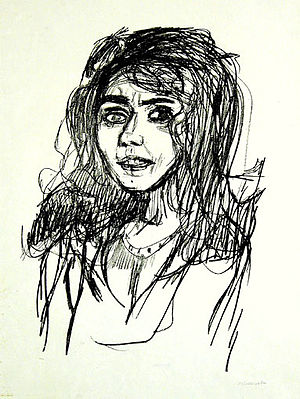- Maria Orska
-
Maria Orska
Photographed by A.Macsigay, Hamburg; card published by Photochemie, Berlin.
Maria Orska on promotional postcard from ca 1920.Born Rachel Blindermann
March 16, 1896
Mykolaiv, UkraineDied May 16, 1930 (aged 34)
Vienna, AustriaOther names Maria Daisy Orska Ethnicity Jewish, Polish Spouse Hans von Bleichröder Maria Orska (Russian: Мария Орская; * March 16, 1896 - † May 16, 1930) was an important actress of the German theater and cinema in the 1920s.
Maria Orska was born as Rachel Blindermann in 1896, of a Polish-Jewish family, in a city of Mykolaiv (Russian: Nikolaev), not far from Odessa, in what is now Ukraine, at the time a part of Russian Empire. Just before World War I Maria Orska moved to Warsaw and from there she moved to Berlin in 1915, as Warsaw has been occupied by German army during the war. She spoke fluently Polish, German and Russian.
In Berlin, Maria Orska worked with Max Reinhardt and was famous for her parts in theater plays by Strindberg, Wedekind and Pirandello. She also gained national popularity in Germany for her film parts, although theater was always more important to her. Her first movie Dämon und Mensch (1915) was produced by Jules Greenbaum, one of the pioniers of the German cinema, who discovered cinema during his 20 years long stay in Chicago and migrated back to Germany in 1895. Most of her movies were produced by Alfred Maack, director and producer employed by Greenbaum. She was sometimes credited in films and film publicity materials as Maria Daisy Orska.
Oskar Kokoschka drew in 1922, a famous portrait of her, now kept as a lithograph in collections of several museums. Orska married an important Jewish banker from Berlin, much older than she was, Baron Hans von Bleichröder (son of Gerson von Bleichröder) and took a name of Baroness von Bleichröder. They were divorced in 1925. Maria Orska's lover, a wealthy Jewish industrialist and geologist Julius Heinrich Koritschoner from Vienna, shot himself in Constantinople in 1928, writing before death a letter to Orska. His morphine addiction is thought to have made him suicidal.
Maria Orska's sister Gabryela Marchesa di Serra Mantschedda, married to an Italian aristocrat, had committed suicide in 1926, by hanging herself on a curtain rope in a Berlin hotel, after a heated argument with Maria.
Maria Orska had an enormous popularity in Central Europe of the 1920s. Her stage performances at The Hebbel-Theater in the Kreuzberg district were seen as extraordinary by the Berlin audience of that era. Her photographs appeared on covers of magazines, postcards with her portraits were distributed all over that part of the continent.
Maria Orska committed suicide in 1930, in Vienna. Some people speculate that an addiction to morphine had a decisive influence on the last years of her life.
Filmography
- 1915 Dämon und Mensch
- 1915/1916 Das tanzende Herz
- 1916 Die Sektwette
- 1916 Der lebende Tote
- 1916 Der Sumpf
- 1916 Das Geständnis der grünen Maske
- 1916 Adamants letztes Rennen
- 1917 Die schwarze Loo
- 1920 Die letzte Stunde. Der Tag eines Gerichtes in 5 Verhandlungen
- 1920/1921 Die Bestie im Menschen
- 1920/1921 Der Streik der Diebe
- 1922 Opfer der Leidenschaft
- 1922/1923 Fridericus Rex. 3. Sanssouci
External links
- Maria Orska at the Internet Movie Database
- "Tyrolese Dynamite". Time Magazine. 1926-02-22. http://www.time.com/time/magazine/article/0,9171,721643,00.html. Retrieved 2008-08-09.
- Testimony about Maria Orska's lover Julius Heinrich Koritschoner and the society of artists and financiers in Vienna which Maria Orska was a part of
- Description of the Maria Orska suicide presently at Harvard University, School of Law, in Wood Detective Agency. Records, 1865–1945
- Postcards
- [1] IMDB
See also: OrskiCategories:- Polish film actors
- German silent film actors
- Polish expatriates in Ukraine
- Polish expatriates in Russia
- Polish expatriates in Germany
- Polish expatriates in Austria
- Polish Jews
- Ukrainian Jews
- German nobility
- People from Mykolaiv
- Suicides in Austria
- 1896 births
- 1930 deaths
Wikimedia Foundation. 2010.

